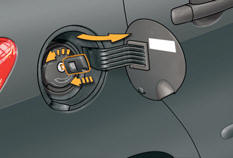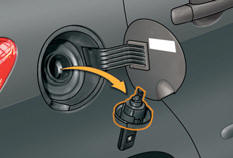Fuel tank
Capacity of the tank: approximately 60 litres.
Low fuel level

When the low fuel level is reached, this warning lamp comes on on the instrument panel, accompanied by an audible signal and an alert message.
When it first comes on, you have approximately 6 litres of fuel remaining.
Until sufficient fuel has been added, this warning lamp comes on every time the ignition is switched on, accompanied by an audible signal and a message.
When driving, this audible signal and the display of the alert message are repeated with increasing frequency as the fuel level drops towards "0" .
Refuel as soon as possible to avoid running out of fuel.
If you run out of fuel (Diesel), refer also to the "Checks" section.
 With Stop & Start, never refuel
with the system in STOP mode; you must switch off the ignition with the key.
With Stop & Start, never refuel
with the system in STOP mode; you must switch off the ignition with the key.
Filling
A label affixed to the inside of the flap reminds you of the type of fuel to be used according to your engine.
More than 5 litres of fuel must be added in order to be registered by the fuel gauge.
To fill the tank safely:
it is essential that the engine is switched off,
open the fuel filler flap,
insert the key in the cap, then turn it to the left,
remove the cap and secure it on the hook, located on the inside of the flap,
fill the tank, but do not continue after the 3rd cut-off of the nozzle ; this could cause malfunctions.
When filling is complete:
refit the cap,
turn the key to the right, then remove it from the cap,
close the flap.
Operating fault
A fuel gauge malfunction is indicated by the return of the fuel gauge needle to zero.
Have it checked by a PEUGEOT dealer or a qualified workshop.


 The key cannot be removed from
the lock until the cap is put back on the tank.
The key cannot be removed from
the lock until the cap is put back on the tank.
Opening the cap may cause an inrush of air. This vacuum, which is perfectly normal, is caused by the sealing of the fuel system.
Quality of the fuel used for petrol engines
The petrol engines are perfectly compatible with E10 or E24 type petrol biofuels (containing 10 % or 24 % ethanol), conforming to European standards EN 228 and EN 15376.
E85 type fuels (containing up to 85 % ethanol) are reserved exclusively for vehicles marketed for the use of this type of fuel (BioFlex vehicles). The quality of the ethanol must comply with European standard EN 15293.
For Brazil only, special vehicles are marketed to run on fuels containing up to 100 % ethanol (E100 type).

Quality of the fuel used for Diesel engines
The Diesel engines are perfectly compatible with biofuels which conform to current and future European standards (Diesel fuel which complies with standard EN 590 mixed with a biofuel which complies with standard EN 14214) available at the pumps (containing up to 7 % Fatty Acid Methyl Ester).
The B30 biofuel can be used in certain Diesel engines; however, this use is subject to strict application of the special servicing conditions. Contact a PEUGEOT dealer or a qualified workshop.
The use of any other type of (bio) fuel (vegetable or animal oils, pure or diluted, domestic fuel...) is strictly prohibited (risk of damage to the engine and fuel system).

See also:
Air filter and passenger compartment filter
Refer to the servicing booklet for details of the replacement intervals for these
components.
Depending on the environment (e.g. dusty atmosphere) and the use of the vehicle
(e.g. city driving) ...
Tyre under-inflation detection
System which automatically and continuously checks the pressure of the tyres
while driving.
Sensors fitted in each valve trigger a warning in the event of problem (speed
above 12 mph (20 km/h)) ...






